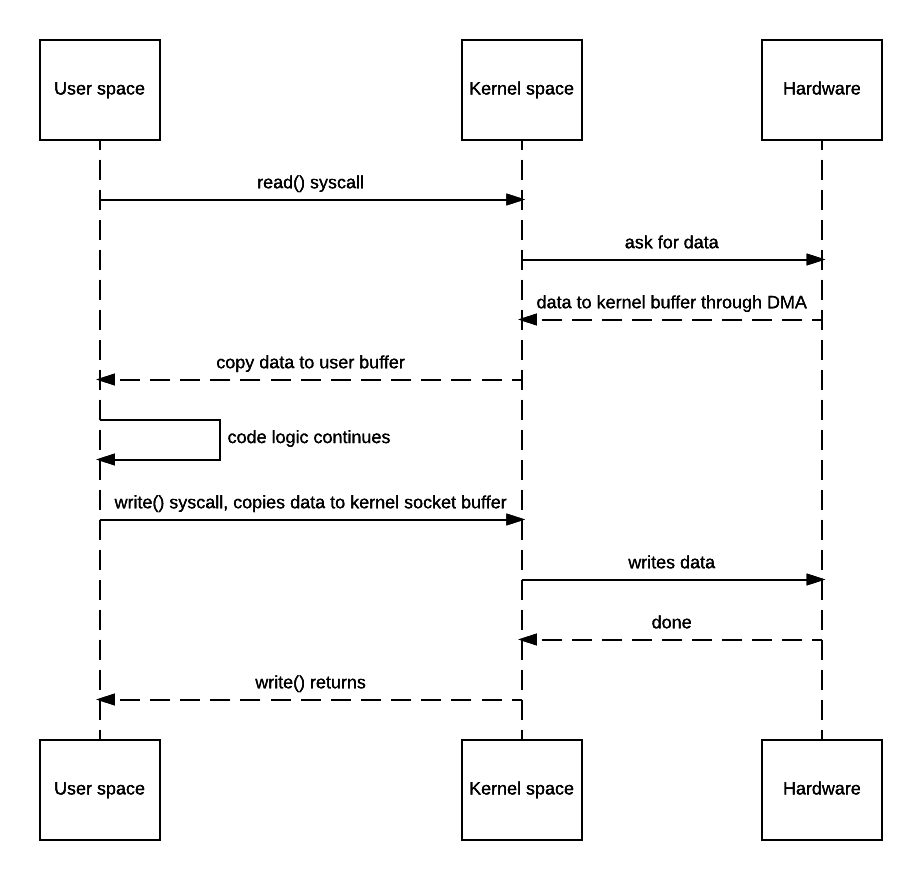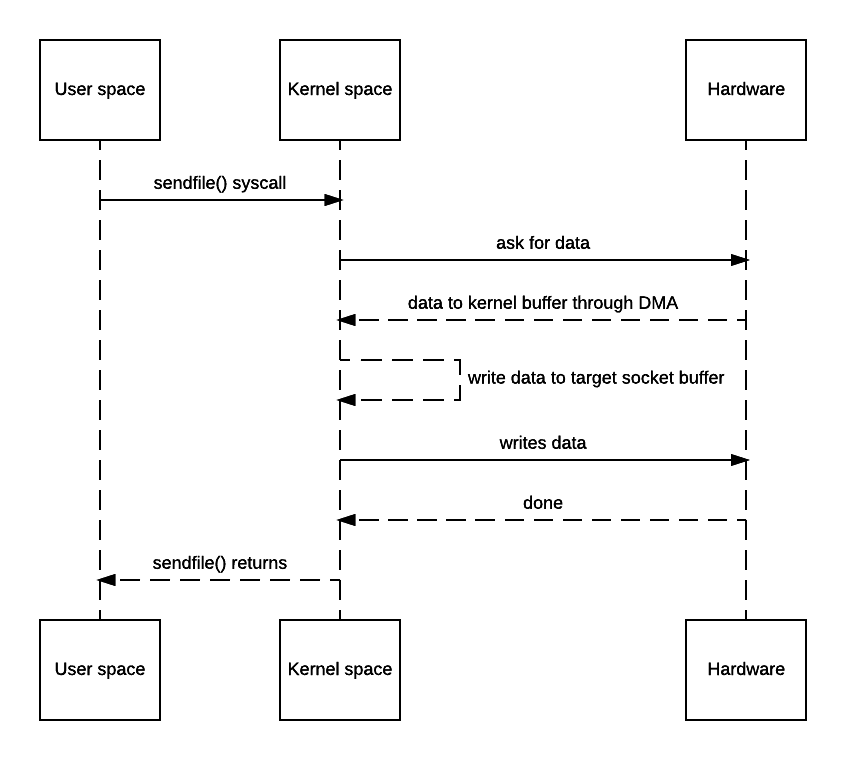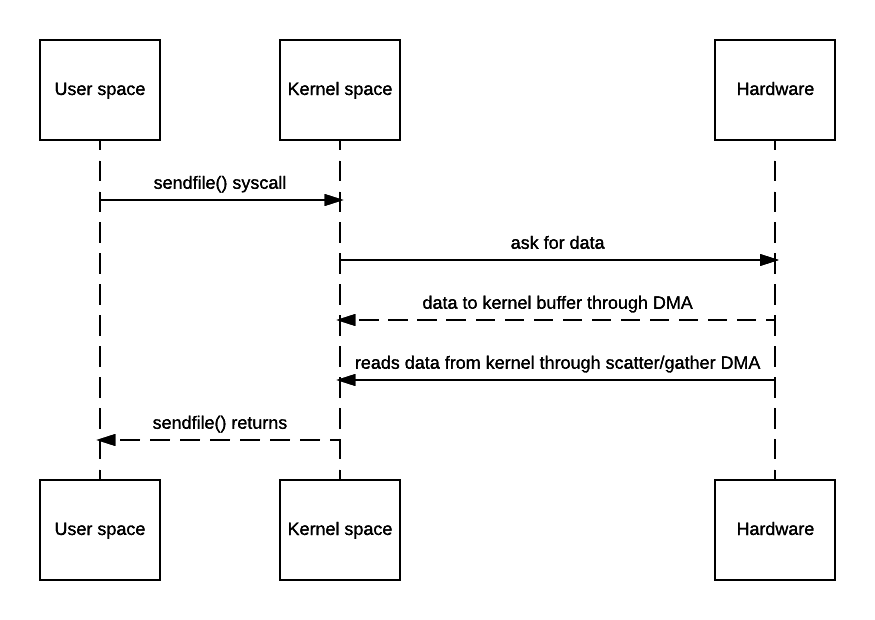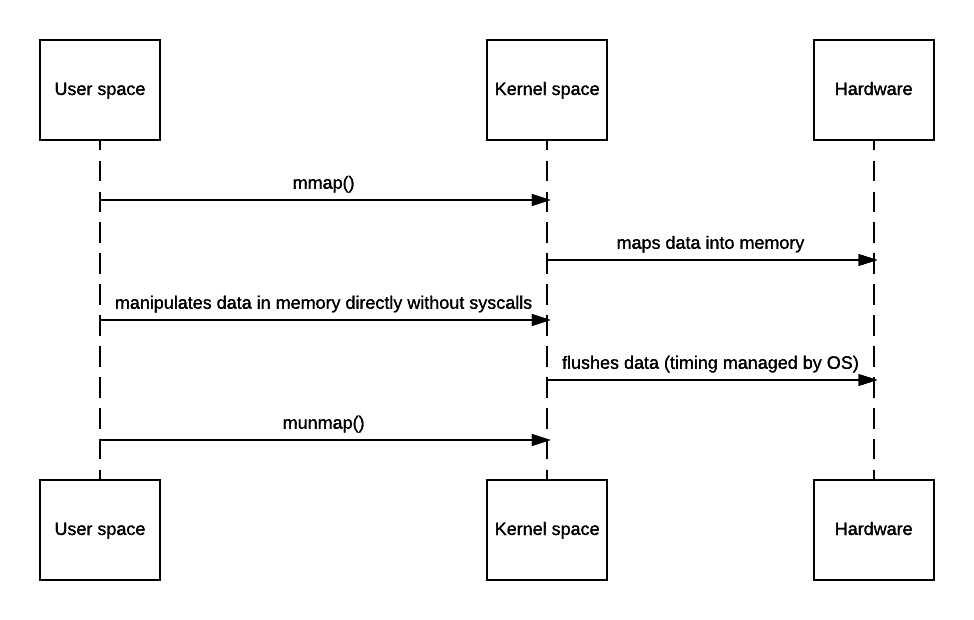IO的详细解释:It's all about buffers: zero-copy, mmap and Java NIO
There are use cases where data need to be read from source to a sink without modification. In code this might look quite simple: for example in Java, you may read data from one InputStream chunk by chunk into a small buffer (typically 8KB), and feed them into the OutputStream, or even better, you could create a PipedInputStream, which is basically just a util that maintains that buffer for you. However, if low latency is crucial to your software, this might be quite expensive from the OS perspective and I shall explain.
What happens under the hood
Well, here’s what happens when the above code is used:

- JVM sends read() syscall.
- OS context switches to kernel mode and reads data into the input socket buffer.
- OS kernel then copies data into user buffer, and context switches back to user mode. read() returns.
- JVM processes code logic and sends write() syscall.
- OS context switches to kernel mode and copies data from user buffer to output socket buffer.
- OS returns to user mode and logic in JVM continues.
This would be fine if latency and throughput aren’t your service’s concern or bottleneck, but it would be annoying if you do care, say for a static asset server. There are 4 context switches and 2 unnecessary copies for the above example.
OS-level zero copy for the rescue
Clearly in this use case, the copy from/to user space memory is totally unnecessary because we didn’t do anything other than dumping data to a different socket. Zero copy can thus be used here to save the 2 extra copies. The actual implementation doesn’t really have a standard and is up to the OS how to achieve that. Typically *nix systems will offer sendfile(). Its man page can be found here. Some say some operating systems have broken versions of that with one of them being OSX link. Honestly with such low-level feature, I wouldn’t trust Apple’s BSD-like system so never tested there.
With that, the diagram would be like this:

You may say OS still has to make a copy of the data in kernel memory space. Yes but from OS’s perspective this is already zero-copy because there’s no data copied from kernel space to user space. The reason why kernel needs to make a copy is because general hardware DMA access expects consecutive memory space (and hence the buffer). However this is avoidable if the hardware supports scatter-n-gather:

A lot of web servers do support zero-copy such as Tomcat and Apache. For example apache’s related doc can be found here but by default it’s off.
Note: Java’s NIO offers this through transferTo (doc).
mmap
The problem with the above zero-copy approach is that because there’s no user mode actually involved, code cannot do anything other than piping the stream. However, there’s a more expensive yet more useful approach - mmap, short for memory-map.

Mmap allows code to map file to kernel memory and access that directly as if it were in the application user space, thus avoiding the unnecessary copy. As a tradeoff, that will still involve 4 context switches. But since OS maps certain chunk of file into memory, you get all benefits from OS virtual memory management - hot content can be intelligently cached efficiently, and all data are page-aligned thus no buffer copying is needed to write stuff back.
However, nothing comes for free - while mmap does avoid that extra copy, it doesn’t guarantee the code will always be faster - depending on the OS implementation, there may be quite a bit of setup and teardown overhead (since it needs to find the space and maintain it in the TLB and make sure to flush it after unmapping) and page fault gets much more expensive since kernel now needs to read from hardware (like disk) to update the memory space and TLB. Hence, if performance is this critical, benchmark is always needed as abusing mmap() may yield worse performance than simply doing the copy.
The corresponding class in Java is MappedByteBuffer from NIO package. It’s actually a variation of DirectByteBuffer though there’s no direct relationship between classes. The actual usage is out of scope of this post.
NIO DirectByteBuffer
Java NIO introduces ByteBuffer which represents the buffer area used for channels. There are 3 main implementations of ByteBuffer:
HeapByteBufferThis is used when
ByteBuffer.allocate()is called. It’s called heap because it’s maintained in JVM’s heap space and hence you get all benefits like GC support and caching optimization. However, it’s not page aligned, which means if you need to talk to native code through JNI, JVM would have to make a copy to the aligned buffer space.DirectByteBufferUsed when
ByteBuffer.allocateDirect()is called. JVM will allocate memory space outside the heap space usingmalloc(). Because it’s not managed by JVM, your memory space is page-aligned and not subject to GC, which makes it perfect candidate for working with native code (e.g. when writing OpenGL stuff). However, you are then “deteriorated” to C programmer as you’ll have to allocate and deallocate memory yourself to prevent memory leak.MappedByteBufferUsed when
FileChannel.map()is called. Similar toDirectByteBufferthis is also outside of JVM heap. It essentially functions as a wrapper around OS mmap() system call in order for code to directly manipulate mapped physical memory data.
Conclusion
sendfile() and mmap() offer efficient, low-latency low-level solutions to data manipulation across sockets. Again, no code should assume these are silver bullets as real world scenarios may be complex and it might not be worth the effort to switch code to them if this is not the true bottleneck. For software engineering to get the most ROI, in most cases, it’s better to “make it right” and then “make it fast”. Without the guardrails offered by JVM, it’s easy to make software much more vulnerable to crashing (I literally mean crashing, not exceptions) when it comes to complicated logic.
https://xunnanxu.github.io/2016/09/10/It-s-all-about-buffers-zero-copy-mmap-and-Java-NIO/
IO的详细解释:It's all about buffers: zero-copy, mmap and Java NIO的更多相关文章
- Java NIO和IO的区别(转)
原文链接:Java NIO和IO的区别 下表总结了Java NIO和IO之间的主要差别,我会更详细地描述表中每部分的差异. 复制代码代码如下: IO NIO面向流 ...
- .htaccess语法之RewriteCond与RewriteRule指令格式详细解释
htaccess语法之RewriteCond与RewriteRule指令格式详细解释 (2012-11-09 18:09:08) 转载▼ 标签: htaccess it 分类: 网络 上文htacc ...
- cookie的详细解释
突然看到网页上中英文切换的效果,不明白怎么弄得查了查 查到了cookie 并且附有详细解释 就copy留作 以后温习 http://blog.csdn.net/xidor/article/detail ...
- tar命令的详细解释
tar命令的详细解释 标签: linuxfileoutputbashinputshell 2010-05-04 12:11 235881人阅读 评论(12) 收藏 举报 分类: linux/unix ...
- Linux学习笔记15——GDB 命令详细解释【转】
GDB 命令详细解释 Linux中包含有一个很有用的调试工具--gdb(GNU Debuger),它可以用来调试C和C++程序,功能不亚于Windows下的许多图形界面的调试工具. 和所有常用的调试工 ...
- C语言 - 结构体(struct)比特字段(:) 详细解释
结构体(struct)比特字段(:) 详细解释 本文地址: http://blog.csdn.net/caroline_wendy/article/details/26722511 结构体(struc ...
- 姿势体系结构的详细解释 -- C
我基本上总结出以下4部分: 1.问题的足迹大小. 2.字节对齐问题. 3.特别保留位0. 4.这种结构被存储在存储器中的位置. #include <stdio.h> #include &l ...
- Java - 面向对象(object oriented)计划 详细解释
面向对象(object oriented)计划 详细解释 本文地址: http://blog.csdn.net/caroline_wendy/article/details/24058107 程序包括 ...
- 设计模式 - 迭代模式(iterator pattern) Java 迭代器(Iterator) 详细解释
迭代模式(iterator pattern) Java 迭代器(Iterator) 详细解释 本文地址: http://blog.csdn.net/caroline_wendy 參考迭代器模式(ite ...
随机推荐
- swoole扩展实现真正的数据库连接池
php的数据库连接池一直以来都是一个难题,很多从php语言转向java的项目,大多数原因可能都是因为java有更好的连接池实现.php的mysql扩展提供了长连接的API,但在php机器数量较多,规模 ...
- fork/join 全面剖析
fork/join作为一个并发框架在jdk7的时候就加入到了我们的java并发包java.util.concurrent中,并且在java 8 的lambda并行流中充当着底层框架的角色.这样一个优秀 ...
- python面向对象学习(三)私有属性和私有方法
目录 1. 应用场景和定义方式 2. 伪私有属性和私有方法 在java或者其他的编程语言中,使用访问修饰符来限制属性和方法的访问级别,一般有public.protected.default.priva ...
- Http协议请求头、响应头、响应码
Http部分请求头 Accept 客户机通过这个头,告诉服务器,它支持哪些数据类型 Accept-Charset 客户机通过这个头,告诉服务器,它支持的编码 Accept-Encoding 客户机通过 ...
- laravel5.5通过Migrations修改表 的artisan命令
1,不同表的修改都需要通过命令创建一个文件 2,首先通过artisan创建对应表的一个文件 php artisan make:module:migration abtinvitcard(模块名) al ...
- express 对数据库数据增删改查
接着 http://www.cnblogs.com/cynthia-wuqian/p/6560548.html (1)概念 Schema(属性) :一种以文件形式存储的数 据库模型骨架,不具备数据库的 ...
- 浅谈css中的盒模型(框模型)
css中的盒模型是css的基础,盒模型的理解可以帮助我们进行对样式进行修改.废话不多说,进入正题: 在w3c中,CSS 框模型 (Box Model) 规定了元素框处理元素内容.内边框.边框 和 外边 ...
- es6 语法 (set 和 map)
{ let list = new Set(); list.add(5); list.add(7); console.log('size', list, list.size); //{5, 7} 2 } ...
- cf932E. Team Work(第二类斯特灵数 组合数)
题意 题目链接 Sol 这篇题解写的非常详细 首先要知道第二类斯特灵数的一个性质 \[m^n = \sum_{i = 0}^m C_{n}^i S(n, i) i!\] 证明可以考虑组合意义:\(m^ ...
- 获取请求的ip工具类
package com.example.util; import javax.servlet.http.HttpServletRequest; /** * get remote msg * 获取访问的 ...
